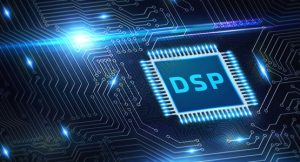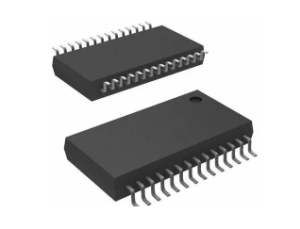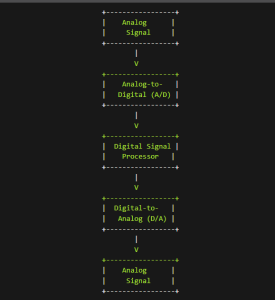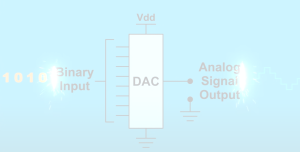
DSP VS DAC: Understanding the Differences, Applications and Future
Global electronic component supplier AMPHEO PTY LTD: Rich inventory for one-stop shopping. Inquire easily, and receive fast, customized solutions and quotes.
Digital-to-Analog Converters (DAC) and Digital Signal Processors (DSP) are two important technologies used in the field of digital electronics. A DAC is used to convert digital signals into analog signals, which can be used to control analog devices such as speakers or motors. DSP plays a critical role in a wide range of applications, including audio and video processing, image processing, telecommunications, control systems, and more. Its ability to efficiently analyze and manipulate signals in real-time makes it an essential technology for the modern digital age. The resolution of the DAC determines the number of different analog values that it can produce. Both technologies have their advantages and disadvantages, and their applications depend on the specific requirements of the digital circuit. In this blog, we will explore the differences between DSP and DAC and their applications.
What is DSP?

Figure 1 What is DSP?
A Digital Signal Processor (DSP) is a specialized microprocessor designed to perform digital signal processing operations on digital signals in real time. It is a type of microprocessor that is optimized for working with digital signals, and it can execute complex mathematical operations quickly and efficiently. DSPs are used in various applications, including audio, image, video, speech, radar, sonar, seismic data processing, control systems, and wireless communication. They are used to perform various operations on digital signals, such as filtering, amplifying, and modulating. DSPs have several features that make them suitable for digital signal-processing applications. For example, they typically have multiple arithmetic logic units (ALUs) and specialized hardware for performing fast multiplication and addition. They also have specialized memory architectures that are optimized for accessing data quickly and efficiently. One of the critical advantages of DSPs is their ability to perform complex mathematical operations quickly and efficiently, making them ideal for real-time signal processing applications. They are also highly programmable, which allows them to be customized for specific applications. Overall, DSPs are an important technology in the field of digital signal processing, and they have enabled the development of many advanced technologies that rely on accurate and efficient digital signal processing.
What is DAC?

Figure 2 What is DAC?
A Digital-to-Analog Converter (DAC) is a device that converts digital signals into analog signals. It takes a digital signal, which is represented by a series of binary values, and converts it into an analog signal that can be used to control an analog device, such as a speaker or a motor. DACs are used in a wide range of applications, including audio playback systems, video playback systems, control systems, and instrumentation. They are used to convert digital signals into analog signals that can drive analog devices. DACs come in a variety of forms, including integrated circuits (ICs), modules, and standalone devices. They typically have several input pins for receiving digital signals and one or more output pins for producing analog signals. One of the key specifications of a DAC is its resolution, which determines the number of different analog values the DAC can produce. The resolution is determined by the number of binary values that the DAC can process, and it is typically expressed in bits. For example, an 8-bit DAC can produce 2^8 (256) different analog values. DACs are an important technology in the field of digital electronics, and they have enabled the development of many advanced technologies that rely on the accurate and efficient conversion of digital signals into analog signals.
How Does DSP Work?
A Digital Signal Processor (DSP) works by performing mathematical operations on digital signals in real-time. DSPs are designed to handle digital signals, which are represented by a series of binary values.

Figure 3 How Does DSP Work
The process starts with an analog signal, which is then converted to a digital signal using an analog-to-digital converter (A/D). The digital signal is then processed using a Digital Signal Processor (DSP), which can perform various functions such as filtering, modulation/demodulation, and signal analysis. Finally, the processed digital signal is converted back to an analog signal using a digital-to-analog converter (D/A) to be outputted to a speaker, amplifier, or another analog device. DSPs have specialized hardware and software that are optimized for digital signal processing operations. They typically have multiple arithmetic logic units (ALUs) and specialized hardware for performing fast multiplication and addition. They also have specialized memory architectures that are optimized for accessing data quickly and efficiently. The basic operations that DSPs perform include filtering, amplifying, and modulating digital signals. For example, a DSP may use a filter algorithm to remove unwanted noise from an audio signal, or it may use a modulation algorithm to add information to a signal for transmission over a wireless communication channel. DSPs are highly programmable, which allows them to be customized for specific applications. They can be programmed using a variety of programming languages, including C, C++, and assembly language. Overall, DSPs are an important technology in the field of digital signal processing, and they have enabled the development of many advanced technologies that rely on accurate and efficient digital signal processing.
The Characteristics of DSP
- High processing power: DSPs are designed to perform complex signal processing operations with high accuracy and speed. They typically have specialized hardware units for performing arithmetic and logic operations, making them much faster than general-purpose processors for signal-processing tasks.
- Fixed-point and/or floating-point arithmetic: DSPs can perform arithmetic operations using fixed-point or floating-point arithmetic, depending on the application requirements. Fixed-point arithmetic is used for applications that require high accuracy with a limited dynamic range, while floating-point arithmetic is used for applications that require a wider dynamic range.
- Multiple data paths: DSPs typically have multiple data paths that allow for parallel processing of data, which improves the overall processing speed.
- Specialized instruction sets: DSPs have specialized instruction sets that are optimized for signal processing tasks, such as filtering, Fourier transforms, and convolution. These instructions allow for efficient processing of signals with minimal instruction overhead.
- Data memory and instruction memory: DSPs typically have separate data and instruction memory, which allows for efficient processing of large data sets.
- Input/output capabilities: DSPs have specialized input/output interfaces that are optimized for interfacing with analog and digital signals. They can interface with a wide range of sensors and actuators, making them suitable for a wide range of signal-processing applications.
- Power efficiency: DSPs are optimized for low power consumption, making them suitable for battery-powered and other low-power applications.
- Real-time processing: DSPs are designed for real-time processing of signals, allowing for rapid and accurate analysis and manipulation of signals in real-time applications.
- Programmability: DSPs are programmable, which allows for flexibility in designing signal processing algorithms and adapting to changing application requirements.
- Debugging and development tools: DSPs come with specialized debugging and development tools that allow for easy development and optimization of signal processing algorithms.
How Does DAC Work?
A Digital-to-Analog Converter (DAC) works by converting a digital signal, which is represented by a series of binary values, into a continuous analog signal. The basic operation of a DAC involves taking a digital signal as input, converting it into an analog signal, and producing an output signal that can be used to control an analog device, such as a speaker or a motor. The conversion process involves several steps. First, the digital signal is sampled at a fixed rate, typically determined by the Nyquist-Shannon sampling theorem, which states that the sampling rate must be at least twice the frequency of the highest frequency component of the input signal. Next, the digital signal is quantized, which means that each sample is assigned a numerical value that represents the amplitude of the signal then. The quantization process involves rounding the numerical value to the nearest level that the DAC can produce, based on its resolution. Once the signal is quantized, it is converted into an analog signal using a process called pulse-width modulation (PWM). The PWM process involves generating a series of pulses with varying widths, where the width of each pulse corresponds to the amplitude of the digital signal then. The pulse train is filtered to remove high-frequency components, resulting in a continuous analog signal that can be used to control an analog device. The output of a DAC is typically represented by a voltage or current that varies continuously over time. The resolution of the DAC, which is determined by the number of bits it can process, determines the number of different analog values that the DAC can produce. For example, an 8-bit DAC can produce 2^8 (256) different analog values. Overall, DACs are an important technology in the field of digital electronics, and they have enabled the development of many advanced technologies that rely on the accurate and efficient conversion of digital signals into analog signals.

Figure 4 How Does DAC Work
The Characteristics of DAC
- Resolution: DACs have a resolution that determines the number of bits used to represent the analog signal. Higher-resolution DACs provide a more accurate representation of the analog signal and can produce higher-fidelity sound.
- Sampling rate: DACs have a sampling rate that determines how often the digital signal is converted to an analog signal. Higher sampling rates provide a more accurate representation of the original signal and can produce higher-quality audio.
- Output voltage range: DACs have an output voltage range that determines the range of voltages that the analog signal can be converted to. This range can vary depending on the specific DAC and the application requirements.
- Output impedance: DACs have an output impedance that determines the load that the DAC can drive. The output impedance of the DAC should match the input impedance of the load to ensure proper signal transmission.
- Linearity: DACs have a linearity specification that determines how accurately the output voltage corresponds to the digital input value. Higher linearity DACs provide a more accurate representation of the original signal.
- Noise: DACs can introduce noise into the analog signal due to imperfections in the conversion process. Lower noise DACs produce a cleaner and more accurate analog signal.
- Power consumption: DACs consume power during the conversion process, and the power consumption can vary depending on the specific DAC and the application requirements.
- Interface: DACs typically have an interface for receiving digital signals, such as a serial interface or a parallel interface. The interface used can affect the speed and ease of use of the DAC.
- Output type: DACs can have different types of analog outputs, such as voltage output, current output, or differential output. The output type can affect the ease of use and compatibility with other components in the system.
- Package type: DACs come in various package types, such as through-hole, surface mount, or ball grid array. The package type can affect the ease of use and compatibility with other components in the system.
The Difference between DSP and DAC
A DSP is a specialized microprocessor designed to manipulate digital signals using mathematical algorithms. It is used to perform a wide range of operations on digital signals, such as filtering, amplifying, and modulating. The main function of a DSP is to process digital signals in real-time, and it can be customized for specific applications. In contrast, a DAC is a device that converts digital signals into analog signals. It takes a digital signal, which is represented by a series of binary values, and converts it into an analog signal that can be used to control an analog device, such as a speaker or a motor. The main function of a DAC is to convert digital signals into analog signals that can drive analog devices. In summary, the main difference between a DSP and a DAC is their function. A DSP is a microprocessor designed to manipulate digital signals, while a DAC is a device designed to convert digital signals into analog signals. Both technologies are important in digital electronics and have a wide range of applications in various fields.
The Application of DSP and DAC
The application of DSP
The automotive and industrial fields have also increased in adoption of DSP systems. DSP systems are utilized in power management, engine control, and even safety systems like anti-lock brakes, airbag deployment, and traffic control. In industrial settings, DSP systems are employed in process control systems and power management control systems. These systems can help to improve the efficiency and safety of industrial processes and can help to reduce costs and improve productivity. Data compression, digital image processing, audio coding, video coding, image compression, signal processing for control systems, telecommunications, seismology, biomedical engineering, etc. are just a few of the applications for DSP. Other applications include processing of audio and speech, radar, sonar, and other sensor array processing, statistical signal processing, spectral density estimation, data compression, digital image processing, and data compression. A digital signal processor is a particular type of microprocessor as a result. This processor's primary job is to measure and compress and filter analog signals. Due to power usage restrictions and their typical higher power efficiency, digital signal processors are typically utilized in portable devices like mobile phones. These processors commonly fetch many pieces of data or instructions simultaneously using unique memory architectures.
The application of DAC
DAC (Digital-to-Analog Converter) is a device or integrated circuit that converts digital signals into analog signals. It takes a series of digital values and converts them into a continuous analog signal that can be used to drive speakers or other analog devices. DACs are used in a wide range of applications, including:
- Audio playback: DACs are commonly used in audio playback devices such as CD players, digital audio players, and smartphones. They convert digital audio signals, stored in a digital format such as MP3 or FLAC, into analog signals that can be played on speakers or headphones.
- Instrumentation: DACs are used in instrumentation and measurement systems to convert digital signals from sensors into analog signals that can be used for analysis or control.
- Video playback: DACs are used in video playback devices such as DVD players and Blu-ray players to convert digital video signals into analog signals that can be displayed on a TV or monitor.
- Industrial control: DACs are used in industrial control systems to convert digital signals into analog signals that can be used for controlling equipment such as motors, actuators, and valves.
- Communications: DACs are used in communication systems such as modems and cellular networks to convert digital signals into analog signals that can be transmitted over communication channels.
- Test and measurement: DACs are used in test and measurement systems to generate analog signals for testing electronic circuits and systems.
In summary, DACs are used in a wide range of applications where digital signals need to be converted into analog signals for playback, analysis, or control. DSP systems are incredibly versatile and can be used in a wide range of applications. As technology continues to advance, we will likely see even more innovative uses for DSP systems in the future.
The Future of DSP and DAC
The future development of Digital Signal Processors (DSPs) and Digital-to-Analog Converters (DACs) is ongoing, with continued advancements in technology and capabilities. Here are some potential areas for further development: DSPs:
- More powerful and energy-efficient processors: As digital signal processing becomes more complex and demanding, there is a need for more powerful processors that can handle larger amounts of data and perform more complex mathematical operations. There is also a need for energy-efficient processors that can operate for longer periods without needing to be recharged.
- More specialized applications: DSPs are already used in a wide range of applications, but there is potential for even more specialized applications. For example, DSPs could be developed specifically for use in medical imaging or autonomous vehicles.
- Improved algorithms and software: The algorithms and software used by DSPs can be improved and optimized for specific applications, leading to better performance and efficiency.
DACs:
- Higher resolution and accuracy: As digital systems become more advanced, there is a need for DACs that can produce higher resolution and more accurate analog signals.
- More efficient conversion: There is a need for DACs that can convert digital signals into analog signals more efficiently, with less power consumption and less noise.
- More specialized applications: DACs can be developed for specific applications, such as high-fidelity audio playback or high-precision control systems.
Overall, the future of DSP and DAC is promising due to advancements in technology and the growing demand for high-quality audio and video. DSP is focusing on artificial intelligence and machine learning algorithms to enhance accuracy and efficiency, leading to advanced signal processing capabilities like real-time noise reduction and voice recognition. DAC focuses on improving resolution, accuracy, and reducing distortion. Higher sampling rates and bit depths are also being developed, resulting in more accurate analog signal representations. The integration of DACs into smaller, more efficient packages is also gaining popularity in mobile devices and portable applications. As these fields evolve, new and innovative products and solutions will shape the future of digital signal processing and conversion.
Related Articles
- ·Is FPGA chip suitable for algorithm development?
- ·What are the advantages and disadvantages of using SoCs in embedded systems?
- ·What are the differences between FPGA and DSP processors for signal processing?
- ·Digital Signal Processors vs x86 Architecture, What's the Different?
- ·How to Use DDR Memory with FPGA for DSP Application?
- ·Application of Embedded Systems in Aerospace and Defense Fields
- ·Comparison of FPGA, ARM, STM32, and DSP Platforms
- ·Comparison of FPGA, CPLD, PLC, Microprocessor, Microcontroller & DSP
- ·The composition, functions, advantages, and disadvantages of FPGA
- ·Understand the differences between CPU, GPU, IPU, NPU, TPU, LPU, MCU, MPU, SOC, DSP, FPGA, ASIC, GPP, and ECU
